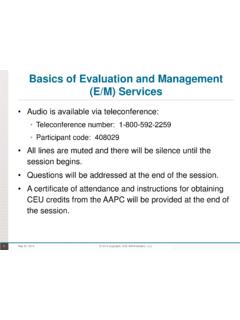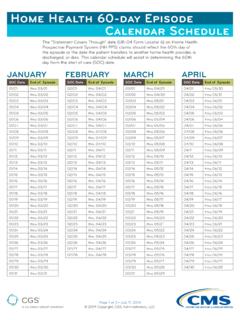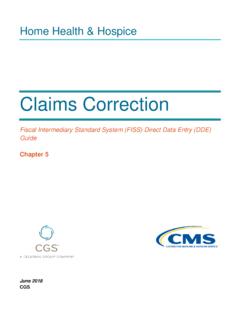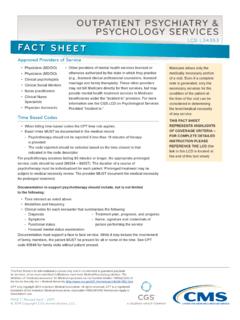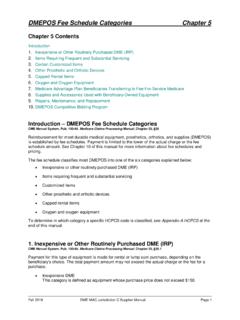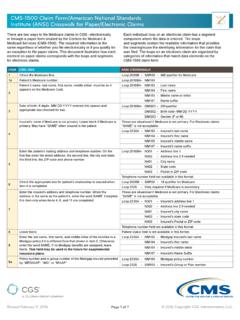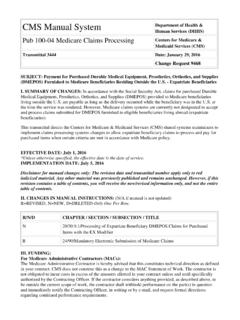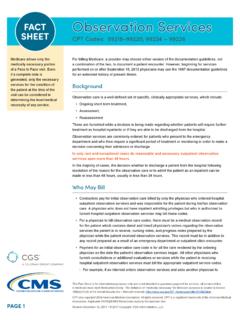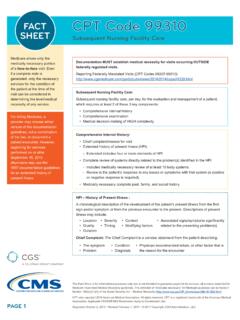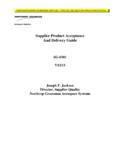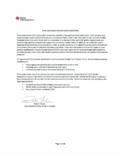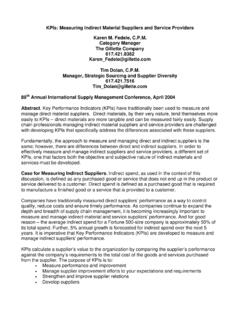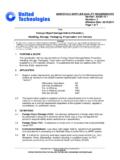Transcription of The history should paint a picture of your patient's ...
1 TWO VANTAGE WAY | NASHVILLE, TN 37228-1504 | DOCUMENTATION REQUIREMENTS FOR POWER WHEELCHAIRS AND POWER OPERATED VEHICLES. Revised October 2018. We IMPACT lives. Dear Physician, This information is not intended to serve as a substitute for the complete DME MAC local coverage determination on Power Mobility Devices. It is only a synopsis detailing the highlights of required medical documentation. Please refer to the complete LCD and Policy Article on the CMS website at for additional information. In order for Medicare to provide reimbursement for a power wheelchair (PWC) or power operated vehicle (POV).
2 (scooter), there are several statutory requirements that must be met: 1. There must be an in-person visit with a clinician specifically addressing the patient's mobility needs. 2. There must be a history and physical examination by the clinician or other medical professional (see below). focusing on an assessment of the patient's mobility limitation and needs. The results of this evaluation must be recorded in the patient's medical record. 3. A prescription must be written AFTER the in-person visit has occurred and the medical evaluation is completed. 4. The prescription and medical records documenting the in-person visit and evaluation must be sent to the equipment supplier within 45 days after the completion of the evaluation.
3 The in-person visit and mobility evaluation together are often referred to as the "face-to-face examination.". The complete history and physical examination must include a history of your patient's medical condition(s) and past medical history that are relevant to their mobility; and a physical examination that is relevant to their limitations in accomplishing mobility-related activities of daily living (MRADLs). The history should paint a picture of your patient's functional abilities and limitations in their home on a typical day. It should contain as much objective data as possible.
4 The physical examination should be focused on the body systems that are responsible for the patient's ambulatory difficulty or impact on the patient's ambulatory ability. Vague terms such as difficulty walking or upper extremity weakness are insufficient, since they do not objectively address the mobility limitation or provide a clear picture of the patient's mobility deficits in participating in MRADLs. A power mobility device is covered by Medicare only if the beneficiary has a mobility limitation that significantly impairs their ability to perform their MRADLs within the home.
5 Thus, in your evaluation you must clearly distinguish your patient's mobility needs within the home from their needs outside the home. You may elect to refer the patient to another medical professional, such as a physical therapist or occupational therapist, to perform part of the evaluation as long as that individual has no financial relationship with the wheelchair supplier. However, you do have to personally see the patient before or after the PT/OT evaluation. You must review their report, indicate your agreement in writing on the report, and sign and date the report.
6 If you do not see the patient after the PT/OT evaluation, the date that you sign the report is considered to be the date of completion of the face-to-face examination. You should record the visit and mobility evaluation in your usual medical record-keeping format. Many suppliers may provide forms for you to complete. Suppliers often try to create the impression that these documents are a sufficient record of the in-person visit and medical evaluation. Based upon our auditing experience, most of them are not. 2018, CGS Administrators, LLC. CGS Administrators, LLC is a Medicare Part A, B, Home Health and Hospice, and DME Medicare Administrative Contractor for the Centers for Medicare & Medicaid Services.
7 You may write a prescription for a power mobility device ONLY after the visit and examination are complete. Please review our Standard Documentation Requirements article (A55426, database/ ) for what is required. This document can be found on all of the DME MAC websites and on the CMS Medicare Database. You must forward a copy of the face-to-face evaluation and your seven-element prescription to the supplier within 45. days from the completion of the face-to-face mobility exam. You should also include copies of previous notes, consultations with other clinicians, and reports of pertinent laboratory, x-ray or other diagnostic tests if they will help to document the severity of your patient's ambulatory problems.
8 After the supplier receives your order and the face-to-face information, they will prepare a detailed product description that describes the item(s) being provided including all options and accessories. You must review it and, if you agree with what is being provided , sign, date and return it to the supplier. If you do not agree with any part of the detailed product description, you should contact the supplier to clarify what you want the beneficiary to receive. Medicare does provide you additional reimbursement (HCPCS code G0372) to recognize the additional time and effort that are required to provide this documentation to the supplier.
9 This code is payable in addition to the reimbursement for your E&M visit code. Your participation in this process and cooperation with the supplier will allow your patient to receive the most appropriate type of mobility equipment. We appreciate all your efforts in providing quality services to your Medicare patients. Sincerely, Wilfred Mamuya, MD, PhD Robert D. Hoover, Jr., MD, MPH, FACP. Medical Director, DME MAC, Jurisdiction A Medical Director, DME MAC, Jurisdiction C. Noridian Healthcare Solutions CGS Administrators, LLC. Stacey V. Brennan, MD, FAAFP Peter J.
10 Gurk, MD, CPE, CHCQM. Medical Director, DME MAC, Jurisdiction B Medical Director, DME MAC, Jurisdiction D. CGS Administrators, LLC Noridian Healthcare Solutions
